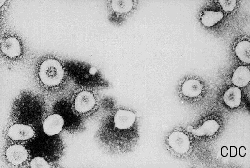There are numerous coronaviruses which are implicated in the spread of the
cold. Here, we focus on one particular virus, OC43.
Human Coronavirus OC43

Incubation:
HCoV
OC43 has a relatively quick incubation period.†
Symptoms usually appear 2-4 days after infection.
Epidemiology:
Generally, human coronavirus
infections occur during the winter and early spring.† HCoV
OC43 is endemic in the human population.†
Infections by HCoV OC43
usually peaks every 2 or 3 years.†
The virus infects all age groups equally and is prevalent throughout the
entire world.† HCoV OC43 (with HCoV 229E) are
responsible for approximately 10-30% of all common colds.† Unfortunately, however, the epidemiology of
this virus is not well understood.
Symptomatology and outcome:†
HCoV
OC43 is a group 2 coronavirus
that results in the symptoms of the common cold.† Some of the symptoms that result are fever,
cough, sore throat, digestive problems, rhinitis, rhinorrhoea,† pharyngitis,
laryngitis, otitits,
bronchitis, bronchiolitis,
and pneumonia.† Studies show that HCoV OC43 is largely responsible
for lower respiratory tract infections.† Reinfections are common with HCoV OC43 as there are many
strains of this virus and it is easily and quickly transferred from human to
human through a respiratory route.†
Prevention and management:
No drugs are available that can cure the common cold.† Some drugs, however, can be used to treat the symptoms of the common cold:
- Decongestants cause constriction in the blood vessels in the membranes of the nose and air passages which ultimately leads to decreased congestion and nasal secretions.
- Antitussives act on the brain to depress the nervous system to suppress coughing.
- Expectorants cause the thinning of respiratory secretions which ultimately makes coughs more productive.
- Antipyretics can be used to lower fever by affecting thermoregulation in the CNS and by inhibiting the action of prostaglandins peripherally
- Antihistamines
bind to histamine receptors thus blocking the action of histamine which is
responsible for the symptoms of sneezing, congestion, and a runny nose.† The efficacy of antihistamines in treating
the common cold has been questioned as histamine is mainly responsible for
allergic responses of the immune system.
Other methods that can be used to help treat the common cold are :
- Resting in bed
- Drinking plenty of fluids
- Using petroleum jelly for a raw nose
- Gargling
with warm salt water or using throat sprays or lozenges to help soothe a
scratchy or sore throat.
Colds
that result from HCoV OC32 are
self limiting, however, and symptoms usually resolve within a few days.† The prospect of developing a vaccine for the
common cold is very slim as there are so many different viruses in addition to HCoV OC43 that cause the common
cold.
Because the common cold is so prevalent and easily transmissible, it is unfortunately very difficult to completely prevent acquiring this disease.† However, here are some methods that can be used to keep yourself from getting a cold or passing one on to others are:
- Wash your hands frequently with both soap and water.† When water isnít available, use alcohol-based products that are made for washing and disinfecting your hands.
- Disinfect environmental surfaces frequently with a virus-killing product.† Coronaviruses can survive outside the body for a short period time and disinfecting surfaces will help to prevent the spread of infection.
- †Keep your hands away from your eyes and nose as HCoV OC43 can easily enter your body through these orifices.
- Avoid
being close to people who have colds.